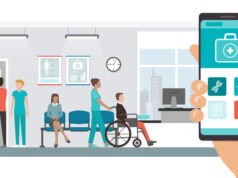
Long before the term Covid-19 was part of our vernacular, hospitals were experiencing rising rates of clinician burnout, and the complexity of our healthcare system was placing undue stress and anxiety on patients. But, the last year and a half has been unprecedented for our industry. Those in healthcare watch it unfold daily — the fear and exhaustion, the uncertainty spurred by required isolation levels and disjointed communications–the engagement gap will continue to widen if the industry does not act.
Though healthcare technology is not able to suit up and physically join the care team, and IT specialists might not be able to personally assuage patient fears, there are ways leaders in the healthcare IT space can help create environments that support care teams, patients, and families, to lessen or eliminate gaps in care and engagement.
It starts with setting the right tone for patients when they first enter the hospital room. Healthcare leaders must think of the hospital room as the patient’s space and leverage technology with the patient in mind. Modern patient engagement platforms can address a patient by name and personalize their care experience by delivering customized education, entertainment, and relaxation to their bedside. They can also transform formerly reactive devices such as the in-room TV into an interactive system that puts everything at the patient’s fingertips. As patients become more informed and start to feel like part of the care team, they can ask questions, raise concerns, and proactively prepare for discharge. It’s a simple way to provide patients with more meaningful interactions, while building deeper relationships, establishing trust, and ultimately fostering loyalty.
Closing the engagement gap requires that technology supports the unique needs and specific workflows of the care team. Administrative tasks such as assigning and documenting educational content, updating dry-erase whiteboards, and triaging service requests, just to name a few, can consume a clinician’s workday. Patient engagement platforms can integrate with existing technology like Real-time Location Systems (RTLS) to prompt the in-room TV or digital whiteboard to automatically display the name, photo, and title for incoming members of the care team. Healthcare technology has the power to build better relationships between clinicians and patients by removing administrative waste and enabling clinicians to practice at the top of their license, giving patients a greater sense of comfort and ease.
It becomes particularly crucial at discharge when closing knowledge gaps and ensuring patients are informed when going home can help to avoid costly readmissions. To optimize patient outcomes and properly manage expectations, providers must integrate discharge planning across the care continuum. Successful discharge planning starts at admission and continues throughout the course of inpatient treatment. Equipped with a data-rich patient engagement platform, providers can harness patient data from a variety of sources to streamline the discharge process, ensure the accurate transfer of information, improve post-discharge outcomes and ultimately enhance the overall patient experience.
Let’s say the patient is in the hospital for a total knee replacement. Rather than having a nurse bring the patient a thick stack of paperwork with forms to sign and discharge education materials to read, the entire process can be automated and paperless. Clinicians can now “prescribe” easily digestible videos for patients to watch on their TV or bedside tablet. Patients can view the videos whenever they want and as many times as they want, enabling repetition that’s so important for comprehension and recall, and closing crucial learning gaps. When patients leave the hospital more educated than when they arrived, readmission rates can be reduced and the potential for positive outcomes increases.
Another vital way to close the engagement gap is for healthcare providers to have real-time access to patient feedback. Surveys initiated through patient room technology focus on many aspects of the care experience that are important to patients and their families, such as access to care, communication with providers, and helpfulness of support staff. The surveys allow patients to report objectively on their experience – without having to feel anxious about giving constructive criticism or offending those on duty.
Yet, engagement gaps aren’t only about clinical knowledge. Other requests, such as housekeeping services or a request for a chaplain can impact patient satisfaction. Real-time surveys delivered to the bedside periodically, or triggered by an event, enable the hospital to better address the unique needs of their patients or perform service recovery in a timelier manner. Patient engagement platforms can even integrate with building management systems to give patients the ability to control their environment to their comfort (room temperature, lights, or shades). By automating service requests to the corresponding department, hospitals reduce the patient’s wait time, increase accuracy of the request, and allow the nurse to concentrate on clinical issues.
For today’s hospitals, addressing patient engagement is not simply a business priority, but rather a moral imperative. Our caregivers are stretched too thin, and our system is overwhelmed. Healthcare consumers are expecting us to push forward and innovate at a rapid pace. Interactive patient systems provide a path forward, bringing much-needed efficiency to day-to-day operations for our caregivers, and providing patients and families with the comfort and information they need during one of the most difficult times in history.
Photo: metamorworks, Getty Images








